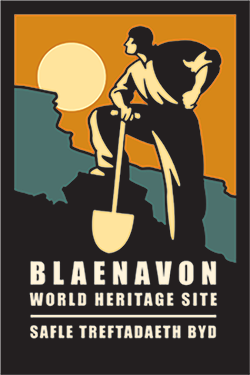Significant Sites
The UNESCO World Heritage Committee inscribed The Blaenavon Industrial Landscape as a World Heritage Site in December 2000 for the following two reasons;
- The Blaenavon Landscape constitutes an exceptional illustration in material form of the social and economic structure of 19th century industry.
- The components of the Blaenavon Industrial Landscape together make up an outstanding and remarkably complete example of 19th century industrial landscape.
Blaenavon is recognised because here is a landscape that gives context to the many monuments, buildings and features within it and tells of the new industrial society created through the production of iron and coal, during the early formative years of the Industrial Revolution.
This is a "cultural landscape" exhibiting the combined works of nature and man.
Features of the World Heritage Site
1) The Blaenavon Ironworks 1789
The Ironworks were the most modern in the world when opened in 1789 and together with other ironworks along the rim of the South Wales coalfield made a quantum leap in iron production and established South Wales as the world’s major producer of iron in the early 19th century. The Ironworks is now the best preserved of its period anywhere and is well maintained and presented by Cadw. The ironworks is the focus of the WHS and the WHS boundaries are drawn around its hinterland.
2) The Big Pit National Mining Museum
Dating from the mid 19th century Big Pit is a completely preserved coalmine. The only complete colliery of the Welsh coal industry, the greatest in the world around 1900.Today visitors can enjoy an underground tour with miners or other exciting presentations of mining heritage on the surface. In 2005 Big Pit won the Gulbenkian UK Museum of the Year Award. It is the main tourist attraction of the World Heritage Site and attracts around 165,000 visitors annually. The site is owned and managed by National Museum Wales.
3) Blaenavon Town
Blaenavon is the best preserved "iron town" in Wales. Here can be seen the slate roofed stone and brick houses of the miners and colliers and also the original churches and chapels and the impressive Workmen's Hall (1894), bearing testament to the tradition of socialism. The town is undergoing a programme of regeneration which has brought back much of its historic attractiveness as it throws off a legacy of deprivation due to the failure of the traditional heavy industries.
4) The Blaenavon World Heritage Centre
The World Heritage Centre, situated in the recently restored St Peter’s School built by the Ironmaster's sister Sarah Hopkins in 1816, is the first dedicated World Heritage Centre in the UK. This attractive building complex provides a Tourist Information Centre and is the focus for intellectual and physical access to the Blaenavon Industrial Landscape.
5) The Landscape and Brecon Beacon's National Park
The World Heritage Site extends to 3,290 hectares; it is spectacular, stretching over the ridge of Blorenge mountain to the Monmouthshire and Brecknock canal in the Usk Valley, near to Abergavenny. Nearly 45% of the World Heritage landscape lies within the Brecon Beacons National Park. The landscape has many features natural and man made, a legacy of early coal and iron extraction, quarries, and a network of tramways which carried some of the world’s earliest iron railways along which have now been developed a network of walks. The archaeological remains of Garn Ddryrys Forge are excitingly perched on the side of the mountain. Garn Ddryrys forge made the "pig iron" from the Blaenavon Ironworks into artefacts such as early iron rails and features in the famous Alexander Cordell novel "Rape of the Fair Country".
6) The Canal
The canal which provided the export import route for iron and coal production from 1817 to 1860 is now a major attraction for leisure cruising. The wharfs at Govilon and Llanfoist have several important historic features dating from the early 19th century.
7) Keeper's Pond
This mountain top pond was created in 1817 to provide a secure water supply to the Garnddyrys Forge below (1818 1860 approx) which is now a fine archaeological site. Keeper's Pond is perhaps the best and most obvious manifestation of a network of ponds and leats in the landscape which were vital in the production process for moving materials and producing power. There is a good car park which serves as a viewing point and entry point to the landscape notably the "Iron Mountain Trail".
8) The Pontypool and Blaenavon Railway
The "steam" railway arrived at Blaenavon in 1856 and caused the closure of the Garn Ddyrys forge on the other side of the mountain which had been served by the Hill’s Tramway taking finished artefacts to the canal for export. A new, modern forge was built at Forgeside below Big Pit which is still in production today although greatly changed. The railway was the highest in the UK and is still in use today (although on a limited length) as a visitor attraction run by enthusiastic volunteers.

